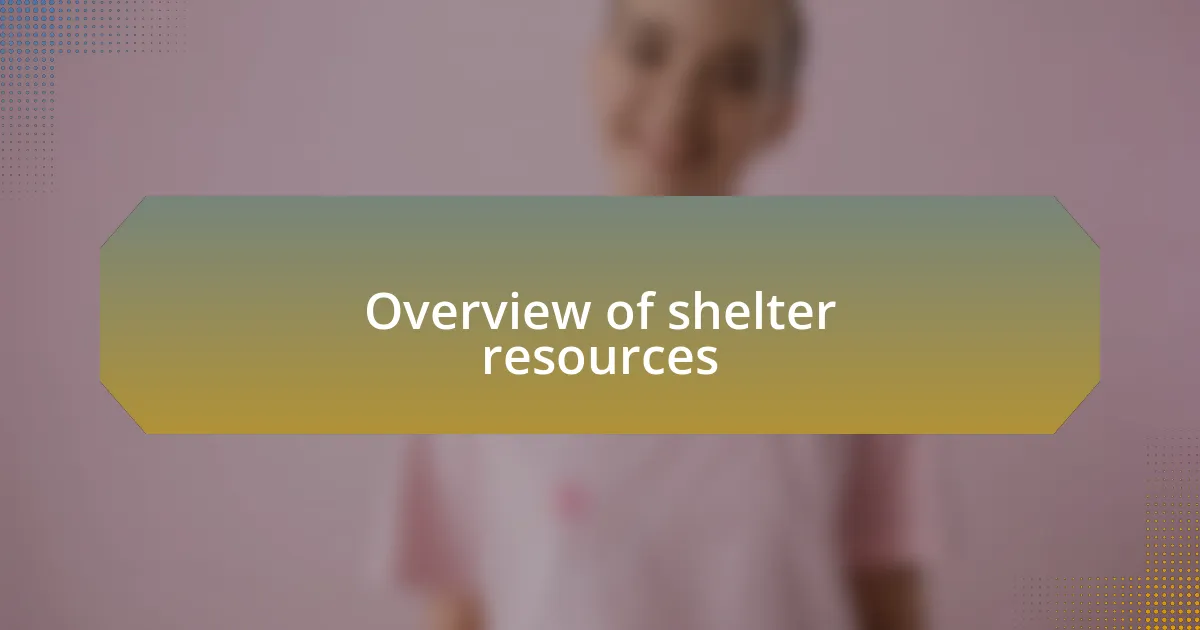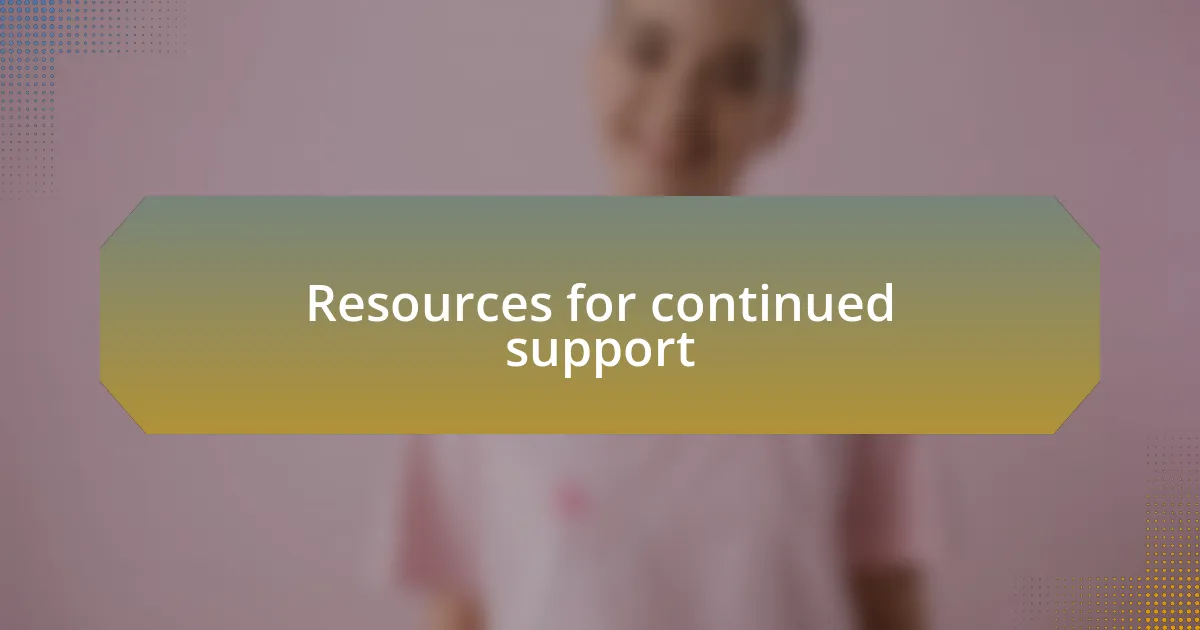Key takeaways:
- Homelessness charities provide holistic support beyond shelter, addressing mental health, employment, and community building.
- A strong support system, including mentors and shared experiences, significantly enhances the chances of successful transition from shelter to permanent housing.
- Accessing tailored resources, such as job training and financial literacy workshops, empowers individuals to regain control over their lives.
- Ongoing support from local organizations and government programs is crucial during the transition, providing essential stability and emotional assistance.

Understanding homelessness charity
Homelessness charity is not just about providing shelter; it’s about offering hope and rebuilding lives. I remember the first time I witnessed the impact of a local charity when I saw a family receive not just a roof over their heads but also support in finding employment and schooling for their children. Isn’t it remarkable that a simple act of kindness can send ripples of change through an entire family?
These organizations often fill gaps that government programs may overlook, focusing on the holistic needs of individuals. From mental health resources to job training, I’ve seen firsthand how tailored support leads to long-term success. How many times have we underestimated the power of addressing both immediate and underlying issues in our quest to combat homelessness?
Engaging with these charities reveals a profound truth: homelessness can happen to anyone, and it often stems from circumstances beyond a person’s control. I recall meeting someone who lost their home due to sudden illness—a situation that can change anyone’s life overnight. What does that say about our societal approach to prevention and support? Understanding homelessness charity means recognizing the human stories behind the statistics, fostering empathy and motivating action.

Importance of support systems
The role of support systems in transitioning from shelter is crucial for anyone trying to rebuild their lives. I vividly remember a woman I met who was struggling to regain her footing after leaving a shelter. She shared how the continuous encouragement from a mentor had helped her stay focused and motivated, proving that emotional support can be just as vital as material assistance.
I’ve often seen that having a reliable support network can significantly improve a person’s chances of success. Consider how difficult it can be to find a job or adapt to a new living situation without friends or family to lean on. Reflecting on my own experience, the friendships I cultivated during my transition provided me not only with practical advice but also with the emotional strength needed to keep moving forward even on the tough days.
It’s interesting to think about how we might underestimate the importance of community in this process. When I joined a support group composed of people who had similar experiences, I realized how much strength comes from shared stories and mutual support. I can’t help but wonder—how many individuals might find their path back to stability if they simply had someone to walk alongside them? The presence of a supportive community can transform the daunting journey of recovery into a more navigable path.

Overview of shelter resources
Shelter resources are incredibly diverse and cater to various needs of individuals transitioning out of homelessness. For instance, when I was in a shelter, I utilized the job placement services they offered, which connected me with local employers willing to hire people in my situation. It’s remarkable how tailored assistance, like resume workshops and interview preparation, can give someone the confidence to step into the workforce again.
I remember attending workshops on financial literacy provided by the shelter, which was transformative. Learning how to budget and manage money helped me regain control over my finances, something that felt daunting after a period of instability. These resources often go beyond basic needs; they empower individuals to take charge of their futures.
Additionally, shelters typically collaborate with mental health professionals to provide counseling services. Personally, accessing therapy through my shelter was a turning point for me—I could unpack the emotional weight I was carrying. This support provided a safe space to heal, reinforcing the idea that addressing emotional wellbeing is just as critical as securing housing or employment. How often do we consider the intertwining of mental health and stability when discussing resources for those in need?

My experience in shelters
Living in a shelter was a unique experience that forced me to confront both my vulnerabilities and my strengths. I can still recall the first night I spent there; the unfamiliar sounds and smells were overwhelming. Yet, it was in those chaotic moments that I found unexpected camaraderie among my fellow residents. We shared stories, struggles, and a common desire to rebuild our lives, which created a sense of community I hadn’t anticipated.
One of the most challenging aspects was the lack of privacy. There were times when I longed for my own space, especially during moments of self-doubt. However, these challenges pushed me to connect with others on a deeper level. For instance, I found solace in late-night conversations with a roommate about our dreams and hopes for the future. How often do we overlook the power of shared experiences in healing? Those connections became lifelines that helped me navigate through the harsh realities of shelter life.
I also vividly remember the encouragement I received from shelter staff. They were truly invested in our growth, which made a significant difference for me. I often think about the mentor who took the time to sit with me and help fine-tune my resume. It wasn’t just about landing a job; it was about giving me a sense of purpose and direction. When was the last time someone believed in you when you didn’t believe in yourself? That belief is a powerful catalyst for change, and it came to mean the world to me during my shelter experience.

Challenges faced during transition
Transitioning from a shelter to permanent housing brought a blend of hope and anxiety. I can distinctly recall that moment when I received my acceptance letter for an apartment; excitement bubbled within me, yet I was also terrified of the responsibilities that lay ahead. How do you move from a space filled with shared experiences to one where you must create your own sanctuary? The mere thought of managing bills and maintaining a household was daunting.
I often found myself grappling with feelings of isolation after moving in. While the community in the shelter was supportive, adjusting to life alone was a struggle. I remember the first evening in my new apartment—silence enveloped me, and memories of laughter and shared meals at the shelter flooded my mind. Did I truly have the skills to thrive independently, or would I fall back into the shadows of uncertainty?
Emotional stability was another challenge throughout my transition. After living with others who understood my journey, the sudden solitude felt overwhelming at times. I recall moments where I questioned my decisions, wondering if I would ever be able to fully embrace my new life. In those moments of doubt, I had to remind myself that change, albeit difficult, was an essential part of growth. How do you reclaim your identity in a world that feels so unfamiliar? It was through small, consistent steps that I began to answer that question for myself.

Strategies for successful transition
Finding support is crucial when navigating the transition from a shelter to your own space. I remember reaching out to a few friends I made at the shelter who had successfully moved into their own homes. Hearing their stories and advice provided reassurance. Their encouragement helped me realize that I wasn’t alone in this journey, and it was okay to seek help.
Developing a structured routine was another effective strategy for me. For instance, I started by allocating specific times for grocery shopping, cleaning, and self-care. Initially, creating a schedule felt restrictive, but it soon transformed into a comforting rhythm. How could a mere timetable foster such a sense of stability? The answer lies in the predictability that routine brought, allowing me to focus on integrating into my new life with less anxiety.
Lastly, embracing community resources was pivotal to my journey. Attending workshops on budgeting and household management made a significant difference. I vividly recall my first budgeting class; I felt overwhelmed by numbers and spreadsheets, yet by the end, I discovered practical skills that empowered me. Did I think I’d ever feel confident managing finances? Absolutely not. Yet, each small victory built my confidence and made the transition smoother.

Resources for continued support
Finding ongoing support often meant utilizing local organizations dedicated to helping individuals like me. I discovered a community resource center that offered not only food assistance but also job training programs. I remember attending a career workshop there—it was intimidating at first, surrounded by people from various backgrounds. But as we shared our experiences, I felt a sense of belonging that I hadn’t expected; it reminded me how important networking is in rebuilding our lives.
Another invaluable resource I found was mental health support. Transitioning from shelter life can be emotionally taxing, and I initially thought I had to handle everything on my own. After joining a support group, I realized I wasn’t the only one struggling with feelings of isolation and uncertainty. Hearing others articulate their fears felt cathartic, and it empowered me to be open about my own challenges. Isn’t it astounding how powerful shared experiences can be in healing?
Finally, I tapped into government assistance programs designed to provide financial stability during the transition period. While applying felt daunting, I learned how crucial it was to advocate for myself. I vividly remember the relief I felt when my application was approved; it wasn’t just financial support—it was like having a safety net that allowed me to breathe easier and rethink my goals. How ironic it is that asking for help, something I once feared, became one of my greatest tools for building a sustainable future.